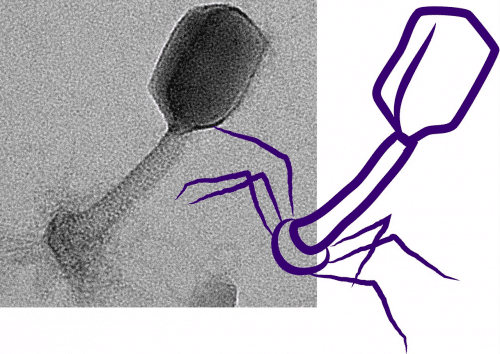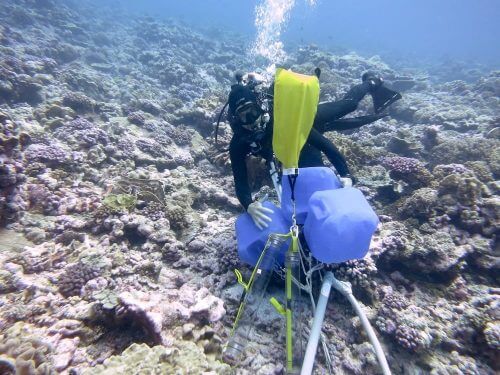A study conducted at the Technion explains how "viral photosynthesis" works, which allows viruses to affect photosynthesis in marine bacteria and use it to their advantage

An article published in the journal Nature Microbiology sheds light on the function of viruses that attack marine bacteria and harness the photosynthesis process to their advantage.
Marine cyanobacteria are responsible for much of the photosynthesis on Earth. In the process of photosynthesis, familiar to us from the plant world, the sun's energy is absorbed and used to convert water and carbon dioxide into organic matter and oxygen. This means that the blue bacteria (cyanobacteria) are an important component of the food web in the sea and the release of oxygen into the atmosphere.
Already in 2009, a group of researchers led by Prof. Oded Beja from the Faculty of Biology at the Technion reported the existence of photosynthetic genes in viruses that attack cyanobacteria. The discovery was based on algorithms for genomic analysis of large populations of microorganisms without the need to grow them in the laboratory (metagenomics). Following the publication, many hypotheses emerged regarding the role of these photosynthetic genes in the infection process and the benefit that the virus derives from them. To test these hypotheses, a process is required that includes the isolation of the virus and its investigation in the laboratory, and this is what was done in the current study.
Dr. Svetlana Friedman from the Faculty of Biology at the Technion, under the guidance of Prof. Oded Beja and Prof. Debi Lindel, focused on the isolation of a virus containing the aforementioned photosynthetic gene array from a seawater sample originating in the central Pacific Ocean. She discovered that the photosynthetic proteins encoded by the virus enter the cell membranes (membranes) of the attacked bacteria and participate in the photosynthetic process. At the end of the infection process, the infected bacterium explodes and dies.

If so, why does the virus carry essential genes for the bacterium if the bacterium is going to die anyway?
The researchers estimate that the answer is "slavery to death". After infection, a significant part of the bacteria's biological functions are silenced and it becomes a "virus production factory". The viral photosynthetic proteins are expressed in the bacterium during infection, participate in the photosynthetic process and even change it. In fact, the virus enslaves the bacteria and uses it to create more copies of the virus in the bacterial cell.
The research was conducted by an international team from Israel, the USA, Spain and France and was funded by the European Research Council, the Israel Science Foundation, the Lori Lockey Interdisciplinary Center for Life Sciences and Engineering at the Technion and the Russell Berry Nanotechnology Institute (RBNI) at the Technion.
According to Prof. Beja, "The research leaves many open questions, for example what is the contribution of this mechanism to the carbon cycle in nature? How much of the bacterial photosynthesis in the marine environment is carried out by the viral proteins?"

7 תגובות
my father
Again and again you show no excess of integrity. Volcanoes under the ice in Antarctica - this is the reason for warming! A virus that attacks algae - this is the reason for the warming!!
What is the human emission? no way! There is no evidence for this! And in general - the earth should be warming up now!
Enough, my father. Please, do not underestimate the intelligence of those who read the site.
Not Ben Ner
Cyanobacteria are an important part of photosynthesis in the world in the absorption of heat and in the production of oxygen in the world.
As a virus attacks such bacteria, I don't think anything good comes of it.
But in biology anything can be
I just hypothesized that it might have an effect, and in general any damage to bacteria or algae in the sea could affect the concentration of the PADH.
Miracles
What you wrote is not relevant to this article and not something I claimed.
On the other hand
Do you know what percentage of PDH is absorbed by algae in the sea in the process of photosynthesis, and how much of it is not absorbed due to a virus that kills algae or another infection that kills algae?
I ask this question because that was the topic, and not what percentage of PADH the person emits.
my father
We know that PADF is a greenhouse gas.
We know what percentage of PAD in the atmosphere is the result of man.
Do you need me to list one of the sentences?
It is possible that it will be possible to isolate the photosynthetic gene from the virus, and "implant"
The same in the chromosomes of the upper leaves. and even in humans.
The result will be green humans with the capacity to produce photosynthesis.
If this indeed succeeds, it will bring an incalculable blessing to humanity.
explanation:
1]. First, photosynthetic people will need to eat much less food
non-photosynthesizers and will produce a large part of the food they need
in the process of photosynthesis.
2]. Second - it is very possible that the process of photosynthesis will cause maximum absorption
The ultraviolet (UV) radiation will prevent, or greatly reduce, the
Its damages such as cancer and possibly sun damage to the eyes.
3]. Third - it will be possible to genetically engineer green insects, green birds, etc.
which will increase the processing of carbon dioxide in the atmosphere
to oxygen, thus contributing to the cooling of the atmosphere and oceans.
4]. Fourth - humanity's general energy consumption will decrease greatly because of exploitation
The energy in the process of photosynthesis will provide humanity with a considerable part
Its energy needs to create food. This will reduce the number of power plants
necessary for humanity, and the environmental pollution will decrease.
In short - the future is pink because it is green.
To my father
It is possible that the effect of the photosynthetic virus is the opposite of what you describe.
Perhaps the photosynthetic virus actually increases the general level of photosynthesis
produced by the bacteria it attacks?
So this virus is supposed to affect global warming.
This virus kills bacteria that have a large and important part in the carbon cycle in nature, writes about the emission of oxygen, but if so it is also about the absorption of carbon dioxide and if so about the concentration of PAD in the air... that is, this virus affects global warming, and probably in a significant way...